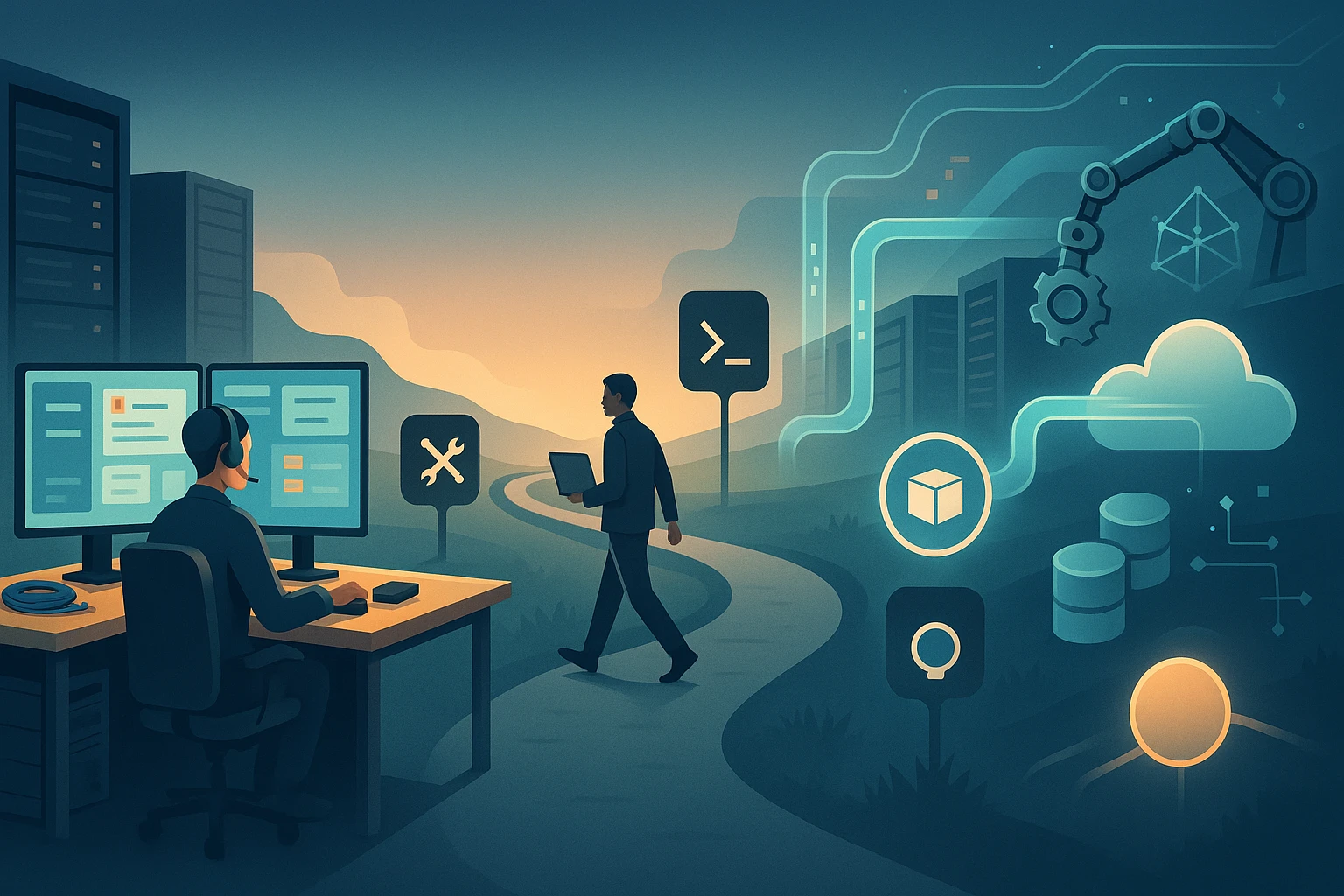From IT Support to DevOps Engineer: Real-World Roadmap
Career roadmap illustration from IT support to DevOps engineer, highlighting skills, tools, certs, hands-on projects, automation, cloud, CI/CD monitoring, collaboration, and growth.

Sponsor message — This article is made possible by Dargslan.com, a publisher of practical, no-fluff IT & developer workbooks.
Why Dargslan.com?
If you prefer doing over endless theory, Dargslan’s titles are built for you. Every workbook focuses on skills you can apply the same day—server hardening, Linux one-liners, PowerShell for admins, Python automation, cloud basics, and more.
The technology landscape is shifting beneath our feet, and IT support professionals are feeling it most acutely. What once was a stable career path—troubleshooting tickets, resetting passwords, managing user accounts—has evolved into something far more dynamic and demanding. Organizations no longer just need people who can fix problems; they need professionals who can prevent them, automate solutions, and bridge the gap between development and operations. This transformation isn't just about job titles; it's about survival and growth in an industry that rewards those who adapt.
DevOps engineering represents more than a career pivot—it's a fundamental shift in how we think about technology infrastructure and software delivery. At its core, DevOps combines software development practices with IT operations, creating a culture of collaboration, automation, and continuous improvement. For IT support professionals, this transition offers multiple perspectives: it's simultaneously a natural evolution of troubleshooting skills, a challenging leap into coding and automation, and an opportunity to become more strategic in how technology serves business objectives.
Throughout this roadmap, you'll discover the practical steps, technical skills, and mindset shifts necessary to make this transition successfully. We'll explore the foundational knowledge you already possess, identify the gaps you need to fill, and provide actionable strategies for building a portfolio that demonstrates your capabilities. Whether you're motivated by career advancement, intellectual curiosity, or the desire to work with cutting-edge technologies, this guide will illuminate the path from reactive support to proactive engineering.
Understanding Your Current Position and Leveraging Existing Skills
IT support professionals possess a treasure trove of skills that translate directly into DevOps work, even if they don't immediately recognize them. Your experience troubleshooting complex technical issues has developed your analytical thinking and systematic problem-solving abilities. Every time you've diagnosed a network connectivity problem, traced application errors through log files, or identified the root cause of a system failure, you've been practicing the investigative skills that DevOps engineers use daily.
The customer service aspect of IT support has also prepared you in unexpected ways. DevOps isn't just about technical prowess; it's fundamentally about collaboration between teams with different priorities and perspectives. Your ability to translate technical concepts for non-technical stakeholders, manage expectations during incidents, and maintain composure under pressure are soft skills that many developers-turned-DevOps-engineers struggle to develop. These communication abilities become invaluable when you're coordinating deployments, explaining infrastructure changes to development teams, or advocating for operational improvements.
"The best DevOps engineers I've worked with came from support backgrounds because they understand the end-user impact of every decision. They don't just build systems; they build systems that people can actually use and maintain."
Your familiarity with various operating systems, networking concepts, and enterprise software provides a practical foundation that purely development-focused individuals often lack. You understand how systems interact in real production environments, not just in idealized development scenarios. This operational awareness—knowing what happens when things go wrong, understanding the importance of monitoring and alertability, recognizing the complexity of enterprise environments—gives you a significant advantage as you transition into DevOps.
| IT Support Skill | DevOps Application | How to Develop Further |
|---|---|---|
| Log analysis and troubleshooting | Debugging deployment issues, monitoring system health, incident response | Learn log aggregation tools (ELK Stack, Splunk), practice writing queries, understand distributed tracing |
| Scripting for repetitive tasks | Infrastructure automation, CI/CD pipelines, configuration management | Advance from basic scripts to modular code, learn version control, study infrastructure-as-code patterns |
| System administration (Windows/Linux) | Server provisioning, container orchestration, cloud infrastructure management | Deepen Linux expertise, learn containerization, understand cloud service models |
| Network troubleshooting | Designing network architectures, configuring load balancers, implementing security groups | Study cloud networking, understand software-defined networking, learn about service meshes |
| Documentation and knowledge sharing | Creating runbooks, documenting infrastructure, writing post-mortems | Learn documentation-as-code approaches, practice technical writing, contribute to open source documentation |
Identifying Your Knowledge Gaps
Honest self-assessment is critical for planning your transition effectively. Most IT support professionals find their gaps cluster around three areas: programming and scripting beyond basic automation, cloud-native architectures and services, and modern development workflows including version control and continuous integration. Recognizing these gaps isn't discouraging—it's empowering because it gives you a clear target for your learning efforts.
Programming represents perhaps the most significant leap for many support professionals. While you may have written PowerShell scripts or bash one-liners, DevOps requires a more structured approach to code. You'll need to understand programming concepts like functions, error handling, data structures, and object-oriented principles. The good news is that you don't need to become a software engineer; you need to become proficient enough to write maintainable automation code and understand the developers' perspective when building deployment pipelines.
Building Your Technical Foundation
The technical journey from IT support to DevOps follows a logical progression, but it's not strictly linear. You'll often find yourself learning multiple skills simultaneously, with each reinforcing the others. The key is to build practical, hands-on experience rather than just consuming tutorials. Every concept should be immediately applied to a project, even if it's just a personal lab environment.
🔧 Mastering Linux and Command-Line Proficiency
Linux forms the backbone of most modern infrastructure, and command-line fluency is non-negotiable for DevOps work. If you've primarily worked in Windows environments, this transition requires dedicated effort. Start by installing a Linux distribution on a virtual machine or using Windows Subsystem for Linux. Your goal isn't just to learn commands but to become comfortable living in the terminal, thinking in terms of pipes and filters, and understanding how Unix philosophy influences modern tooling.
Focus on practical scenarios that mirror real DevOps work: managing users and permissions, understanding process management, working with systemd services, configuring network interfaces, and troubleshooting performance issues. Learn to use tools like grep, awk, sed, and find not just individually but in combination to solve complex problems. Practice reading and modifying configuration files, understanding file system hierarchies, and managing package installations across different distributions.
🐍 Developing Programming Skills
Python has emerged as the lingua franca of DevOps, though bash scripting, Go, and Ruby also have their places. Python's readability, extensive library ecosystem, and versatility make it ideal for infrastructure automation, API interactions, and data processing tasks. Begin with fundamental programming concepts: variables, control structures, functions, and error handling. Then progress to more advanced topics like working with APIs, parsing JSON and YAML, interacting with databases, and understanding asynchronous programming.
"Learning to code as an operations person is different from learning as a developer. You're not building applications; you're building tools that make operations scalable. Focus on practical automation problems you've encountered, and code becomes a means to solve real pain points."
Create small projects that solve problems you've encountered in support work. Build a script that automates user provisioning, create a tool that checks system health across multiple servers, or develop a dashboard that aggregates information from various APIs. These practical projects serve dual purposes: they reinforce your learning and become portfolio pieces that demonstrate your capabilities to potential employers.
☁️ Embracing Cloud Technologies
Cloud computing represents a paradigm shift from traditional infrastructure management. Rather than physical servers and network equipment, you're working with APIs, services, and abstractions. Start with one major cloud provider—AWS, Azure, or Google Cloud—and learn it deeply before exploring others. The concepts translate across platforms, but depth in one provider is more valuable than superficial knowledge of all three.
Focus on core services first: compute instances (EC2, Azure VMs, Google Compute Engine), storage options (S3, Azure Blob Storage, Cloud Storage), networking components (VPCs, security groups, load balancers), and identity management (IAM, Azure AD, Cloud IAM). Understand the pricing models, service limits, and regional considerations. Most importantly, learn to think in terms of cloud-native architectures: ephemeral infrastructure, horizontal scaling, managed services, and distributed systems.
Obtain a foundational certification like AWS Certified Solutions Architect Associate or Azure Administrator Associate. While certifications alone don't make you job-ready, they provide structured learning paths and validate your knowledge to employers. More importantly, preparing for these certifications forces you to explore services and concepts you might otherwise overlook.
Mastering Core DevOps Tools and Practices
DevOps is defined as much by its tooling as by its philosophy. The modern DevOps toolkit is vast and constantly evolving, but certain categories of tools are universal: version control, continuous integration and deployment, infrastructure as code, containerization, and orchestration. Your goal isn't to master every tool but to understand the problems each category solves and become proficient with representative tools from each.
Version Control and Collaboration
Git is the foundation of modern software development and DevOps practices. It's not just about storing code; it's about collaboration, tracking changes, managing releases, and maintaining history. Learn Git beyond the basics: understand branching strategies like GitFlow or trunk-based development, practice resolving merge conflicts, learn to use interactive rebase for cleaning up commit history, and understand how to structure repositories for infrastructure code.
Platforms like GitHub, GitLab, or Bitbucket extend Git with collaboration features: pull requests, code reviews, issue tracking, and CI/CD integration. Contribute to open-source projects to practice collaborative workflows. Even small contributions like documentation improvements or bug reports teach you how professional teams coordinate through version control.
🚀 Continuous Integration and Continuous Deployment
CI/CD pipelines automate the journey from code commit to production deployment, embodying the DevOps principle of rapid, reliable delivery. Start by understanding the conceptual flow: code is committed, automated tests run, artifacts are built, and deployments happen automatically to various environments. Then implement this flow using tools like Jenkins, GitLab CI, GitHub Actions, or CircleCI.
Build pipelines for your personal projects. Create a simple web application and automate its testing and deployment. Implement different strategies: blue-green deployments, canary releases, rolling updates. Learn to handle secrets securely, manage environment-specific configurations, and implement approval gates for production deployments. Understanding CI/CD deeply means recognizing it as a cultural practice, not just a technical implementation—it requires trust, good testing practices, and a commitment to small, frequent changes.
Infrastructure as Code
Infrastructure as Code (IaC) represents one of the most profound shifts in how we manage infrastructure. Instead of clicking through web consoles or running manual commands, you declare your desired infrastructure state in code files. This approach brings version control, code review, automated testing, and repeatability to infrastructure management.
"The moment you start treating infrastructure as code, everything changes. Suddenly you can test infrastructure changes before applying them, roll back bad deployments instantly, and reproduce entire environments with a single command. It's not just more efficient; it's fundamentally more reliable."
Learn both declarative and imperative IaC approaches. Terraform has become the industry standard for cloud-agnostic infrastructure provisioning, using a declarative approach where you specify what you want, and Terraform figures out how to create it. Practice creating modules, managing state files, and organizing Terraform code for real-world complexity. Complement this with configuration management tools like Ansible, which excels at configuring servers and applications after they're provisioned.
| Tool | Primary Use Case | Approach | Learning Priority |
|---|---|---|---|
| Terraform | Cloud infrastructure provisioning, multi-cloud management | Declarative, immutable infrastructure | High - Industry standard for infrastructure provisioning |
| Ansible | Configuration management, application deployment, orchestration | Procedural, agentless | High - Versatile and widely adopted |
| CloudFormation | AWS-specific infrastructure management | Declarative, AWS-native | Medium - Important if focusing on AWS |
| Pulumi | Infrastructure using general-purpose programming languages | Declarative with imperative capabilities | Medium - Growing adoption, leverages existing programming skills |
🐳 Containerization and Orchestration
Containers revolutionized how we package and deploy applications, and Docker has become synonymous with containerization. Start by understanding what containers are and why they matter: they package applications with their dependencies, ensuring consistency across environments and enabling efficient resource utilization. Learn to write Dockerfiles, understand image layers, manage container networking, and work with volumes for persistent data.
Kubernetes represents the next level: orchestrating containers at scale. While Kubernetes has a steep learning curve, it's increasingly expected knowledge for DevOps roles. Begin with core concepts: pods, deployments, services, and ingress controllers. Use managed Kubernetes services like EKS, AKS, or GKE for learning rather than setting up clusters from scratch. Build practical experience by deploying multi-container applications, implementing rolling updates, configuring auto-scaling, and setting up monitoring.
Developing the DevOps Mindset
Technical skills alone don't make a DevOps engineer. The role requires a particular mindset: systems thinking, continuous improvement, collaboration over silos, and a balance between innovation and stability. This cultural shift can be more challenging than learning new tools, especially if you're transitioning from a traditional IT support environment with rigid boundaries between teams.
Embracing Automation and Scalability
DevOps engineers are fundamentally lazy in the best possible way—they refuse to do manually what can be automated. Cultivate an automation-first mindset: whenever you perform a task more than twice, consider automating it. This doesn't mean automating everything immediately, but rather developing the habit of thinking about tasks as potential automation candidates. Learn to evaluate the cost-benefit of automation: some tasks are performed so infrequently that automating them costs more than doing them manually.
"The transition from support to DevOps isn't just about learning tools; it's about changing how you think about problems. In support, you solve issues one at a time. In DevOps, you solve entire classes of problems by building systems that prevent them or resolve them automatically."
Scalability thinking extends beyond technical capacity. Consider how your solutions scale with team growth, infrastructure complexity, and organizational change. Will your automation break when someone modifies a dependency? Can new team members understand and modify your infrastructure code? Does your monitoring strategy scale from ten to ten thousand servers? These questions reveal whether you're thinking like a DevOps engineer or still operating with a support technician's mindset.
Building Observability and Reliability Practices
Your support background gives you an intuitive understanding of why monitoring matters, but DevOps takes this further with the concept of observability: the ability to understand system behavior by examining its outputs. Learn modern monitoring and observability tools: Prometheus for metrics, Grafana for visualization, ELK or Loki for logs, and distributed tracing systems like Jaeger. More importantly, understand what to monitor: the four golden signals (latency, traffic, errors, saturation), business metrics that matter, and user experience indicators.
Site Reliability Engineering (SRE) principles complement DevOps practices by providing frameworks for balancing reliability with innovation. Study concepts like error budgets, service level objectives (SLOs), and blameless post-mortems. These practices help you make data-driven decisions about when to focus on stability versus when to push forward with new features. Understanding SRE principles also makes you more valuable because you can speak to reliability in business terms, not just technical metrics.
Building Your Portfolio and Gaining Experience
Theoretical knowledge means little without demonstrated capability. Your portfolio should tell a story about your DevOps journey, showcasing not just what you can do but how you think about problems. Focus on projects that demonstrate end-to-end understanding: from infrastructure provisioning to application deployment, monitoring, and incident response.
Creating Meaningful Projects
Choose projects that solve real problems or simulate realistic scenarios. Deploy a multi-tier web application with a database backend, implement CI/CD pipelines that include testing and security scanning, create infrastructure that auto-scales based on load, or build a monitoring dashboard that tracks meaningful metrics. Document your projects thoroughly: explain your architectural decisions, discuss trade-offs you considered, and describe how you would improve the solution given more time or resources.
Your GitHub repositories should demonstrate professional practices: clear README files, organized code structure, meaningful commit messages, and appropriate use of branches. Include infrastructure diagrams, explain your repository organization, and provide instructions for others to reproduce your work. This documentation practice shows you understand that DevOps is collaborative and that your code will be maintained by others.
🎯 Contributing to Open Source
Open source contributions provide multiple benefits: you learn from experienced developers' code reviews, you gain experience with professional collaboration workflows, and you build a public record of your capabilities. Start small: fix documentation typos, improve error messages, or add missing test cases. As your confidence grows, tackle more substantial contributions: bug fixes, feature implementations, or performance improvements.
Contributing to DevOps tools themselves offers particular value. Projects like Ansible, Terraform providers, Kubernetes operators, or monitoring tools welcome contributions. Working on these projects deepens your understanding of how the tools work internally, making you more effective at using them professionally.
Gaining Professional Experience
Transitioning roles within your current organization often provides the smoothest path to DevOps work. Look for opportunities to take on DevOps-related responsibilities in your support role: volunteer to maintain CI/CD pipelines, help with infrastructure automation projects, or assist with cloud migrations. These experiences provide real-world context and demonstrate your commitment to professional growth.
"Don't wait for permission to start doing DevOps work. Find the manual, repetitive tasks in your current role and automate them. Build monitoring for systems you support. Create documentation-as-code. These initiatives demonstrate DevOps thinking and often lead to formal role transitions."
If internal transitions aren't possible, consider intermediate positions that bridge support and DevOps: systems administrator with automation responsibilities, cloud administrator, or junior DevOps engineer roles. These positions let you apply your support experience while building DevOps skills in production environments. Be patient with this process; most successful transitions take 12-24 months of focused learning and experience-building.
Navigating the Job Market
The DevOps job market is robust but competitive. Positions often receive hundreds of applications, making it crucial to stand out through your unique combination of support experience and DevOps capabilities. Your resume should tell a story of progression: how you've moved from reactive support to proactive automation, from individual problem-solving to building scalable solutions.
Crafting Your Professional Narrative
Frame your support experience as a foundation for DevOps work rather than something to overcome. Emphasize projects where you automated repetitive tasks, improved system reliability, or collaborated with development teams. Quantify your impact: reduced incident response time by X%, automated Y number of manual processes, or improved system uptime to Z%. These metrics demonstrate business value, not just technical activity.
Your LinkedIn profile and personal website should showcase your DevOps journey. Write articles about technical challenges you've solved, share insights from your learning process, and engage with the DevOps community. This content marketing approach helps recruiters find you and demonstrates communication skills that many technical candidates lack.
Preparing for Technical Interviews
DevOps interviews typically include multiple components: behavioral questions about collaboration and problem-solving, technical questions about tools and practices, and practical exercises like debugging scenarios or infrastructure design challenges. Prepare by practicing common scenarios: designing a CI/CD pipeline, troubleshooting a deployment failure, explaining how you'd implement monitoring for a new service, or discussing trade-offs between different architectural approaches.
Leverage your support background during interviews. When asked about handling incidents, draw on real experiences. When discussing monitoring, explain how you've used observability data to diagnose issues. When talking about automation, share specific examples of manual processes you've automated. Your practical experience with production systems and user impact gives you credibility that purely theoretical knowledge cannot.
🎓 Continuous Learning and Community Engagement
DevOps evolves rapidly, making continuous learning essential. Follow industry blogs, participate in online communities, attend local meetups or virtual conferences, and experiment with emerging tools. Platforms like HashiCorp Learn, AWS Training, Linux Academy, and KodeKloud offer structured learning paths. Books like "The Phoenix Project," "The DevOps Handbook," and "Site Reliability Engineering" provide cultural and philosophical context beyond technical skills.
Join communities where DevOps professionals gather: Reddit's r/devops, DevOps-focused Discord servers, local DevOps meetup groups, or cloud-specific communities. Ask questions, share your learning experiences, and help others who are earlier in their journey. Teaching others reinforces your own understanding and builds your professional network.
Overcoming Common Challenges
Every IT support professional transitioning to DevOps faces similar obstacles. Recognizing these challenges in advance helps you prepare strategies to overcome them rather than being discouraged when they arise.
Imposter Syndrome and Confidence Building
Imposter syndrome strikes particularly hard during career transitions. You're moving from a role where you felt competent to one where you're constantly encountering new concepts and tools. Remember that everyone in DevOps is continuously learning; the field moves too quickly for anyone to know everything. Focus on building depth in core areas rather than superficial knowledge across everything.
"The hardest part of transitioning to DevOps wasn't learning the tools; it was believing I belonged in engineering conversations. My support background made me feel like an outsider until I realized that understanding production systems and user impact was exactly what those conversations needed."
Combat imposter syndrome by documenting your progress. Keep a learning journal where you note new skills acquired, problems solved, and concepts mastered. Review this periodically to recognize how far you've come. Celebrate small wins: your first successful Terraform deployment, your first pull request merged, your first monitoring dashboard that caught a real issue.
Balancing Learning with Current Responsibilities
Transitioning careers while working full-time requires discipline and realistic expectations. You cannot learn everything at once, nor should you try. Create a structured learning plan with specific, achievable goals: complete one certification this quarter, build one portfolio project per month, contribute to open source weekly. Consistency matters more than intensity; 30 minutes of focused learning daily produces better results than occasional marathon sessions.
Protect your learning time by treating it as seriously as work commitments. Schedule specific times for studying, set up a dedicated learning environment, and communicate your goals to family or roommates who might otherwise interrupt. Use techniques like the Pomodoro method to maintain focus during learning sessions, and vary your learning modes—reading, video courses, hands-on labs, teaching others—to maintain engagement.
Dealing with Technical Overwhelm
The DevOps ecosystem's breadth can feel overwhelming. New tools and practices emerge constantly, and it seems impossible to keep up. Accept that you don't need to master everything; instead, develop strong fundamentals that let you quickly learn new tools as needed. Most DevOps tools solve similar problems in slightly different ways. Once you understand CI/CD concepts deeply, switching from Jenkins to GitLab CI becomes a matter of syntax, not fundamental relearning.
When facing a new complex topic, break it into manageable pieces. Instead of trying to learn Kubernetes all at once, start with understanding containers, then move to basic pod management, then services and networking, and gradually progress to advanced topics. Use the Feynman Technique: if you can't explain a concept simply, you don't understand it well enough. Teaching concepts to others or writing explanatory blog posts forces clarity in your own understanding.
Frequently Asked Questions
How long does it typically take to transition from IT support to DevOps engineer?
The timeline varies significantly based on your starting point, available learning time, and target role requirements. Most professionals need 12-24 months of focused learning and practical experience to become competitive for junior DevOps positions. Those with stronger programming backgrounds or more extensive Linux experience may transition faster, while those starting with primarily Windows desktop support experience might need additional time. The key is consistent progress rather than speed—building solid foundations serves you better than rushing through material superficially.
Do I need a computer science degree to become a DevOps engineer?
No, a computer science degree is not required for DevOps roles. Many successful DevOps engineers come from IT support, system administration, or other non-traditional backgrounds. Employers care more about demonstrated skills, practical experience, and problem-solving ability than formal education. However, you will need to self-educate on computer science fundamentals that degree programs cover: networking, operating systems, algorithms and data structures, and software development principles. Certifications, portfolio projects, and professional experience can effectively substitute for formal degrees.
Should I specialize in a specific cloud provider or learn multiple platforms?
Start by developing deep expertise in one major cloud provider—AWS, Azure, or Google Cloud—rather than superficial knowledge of all three. The concepts and services translate across platforms, but depth in one provider makes you immediately valuable to employers using that platform. Once you're proficient with one cloud, learning others becomes much easier because you understand the underlying concepts. Many organizations use multi-cloud strategies, so eventually learning multiple platforms is valuable, but breadth should follow depth, not replace it.
What programming language should I focus on first?
Python is the most versatile choice for DevOps work due to its readability, extensive library ecosystem, and widespread use in infrastructure automation, API interactions, and data processing. However, don't neglect bash scripting, which remains essential for Linux system administration and quick automation tasks. Once you're comfortable with Python, consider learning Go, which is increasingly popular for building DevOps tools and offers excellent performance for system-level programming. The specific language matters less than developing strong programming fundamentals that transfer across languages.
How important are certifications compared to hands-on experience?
Certifications and hands-on experience serve different purposes and are both valuable. Certifications provide structured learning paths, validate baseline knowledge, and help your resume pass initial screening filters, especially when you're transitioning from a different role. However, practical experience demonstrating that you can apply knowledge to real problems matters more to hiring managers. The ideal approach combines both: pursue certifications that force you to learn comprehensively while simultaneously building portfolio projects that demonstrate practical application. Certifications open doors; demonstrated capabilities get you hired.
What if I don't have opportunities to do DevOps work in my current job?
Create your own opportunities by identifying automation possibilities within your current role. Build tools that help your team work more efficiently, automate repetitive support tasks, create monitoring dashboards, or document infrastructure as code. These initiatives demonstrate DevOps thinking even if they're not formally recognized as DevOps work. Additionally, contribute to open-source projects, build personal portfolio projects, participate in hackathons, or offer to help friends or local nonprofits with their infrastructure needs. Professional experience is valuable, but demonstrated capability through side projects and open-source contributions can be equally compelling to employers.




